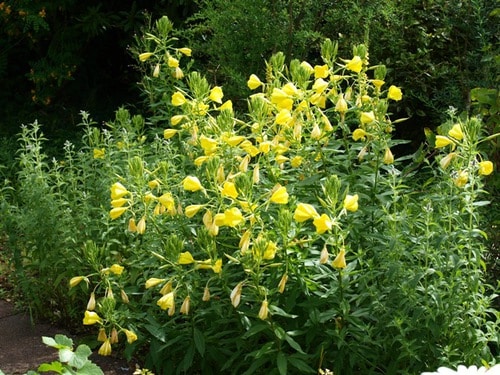Want to grow a late summer and fall blooming plant that attracts butterflies? Try growing evening primrose, which blooms at night with a citrus-like aroma. This easy grower sporting bright yellow flowers lights up the garden after dark like few other blooms can.
Native to North America, evening primrose is grown throughout many parts of the world. In addition to being popular for its bright flowers, the plants are grown to create evening primrose oil, which is available in pill form. The oil of the plant, which is extracted from the seeds and made into capsules, has been used as a remedy for a variety of ailments for decades. Evening primrose oil is said to treat eczema, rheumatoid arthritis and women’s various hormonal problems.
To have luck growing evening primrose, keep the following cultivation tips in mind.
Allow room for spreading. Evening primrose is a spreading and branching plant that can quickly fill up a garden bed or field. The plant is especially useful for hard to landscape areas, such as steep hillsides. When locating evening primrose in the landscape, also consider the fact that they provide fragrance at night, so they are best placed in areas where you spend time in the garden.
 (Michael & Christa Richert/FreeImages.com)
(Michael & Christa Richert/FreeImages.com)
Grow in containers. If you prefer not to let evening primroses loose to roam in your garden, plant these flowers in containers. Grow potted evening primrose on your patio or deck, and you can be sure to enjoy their delightful fragrance at night.
Provide full sun. Evening primrose requires at least six to eight hours of sunlight each day in order to bloom well.
Plant in well-draining soil. Though they aren’t particular about soil type, evening primrose perform best in soil that drains well. Amend the planting area with compost or pumice prior to planting, if drainage is slow. Plant container grown evening primrose in a high-quality potting soil that contains perlite or pumice for drainage.
Water regularly. Though evening primrose is somewhat drought tolerant, it thrives when watered on a regular basis. Irrigate when the top one to two inches of soil has dried out.
Feed once a year. Evening primrose plants aren’t heavy feeders. Get them off to a good start in spring by fertilizing with an organic fertilizer designed for flowering plants.
Julie Bawden-Davis is a garden writer and master gardener, who since 1985 has written for publications such as Organic Gardening, Wildflower, Better Homes and Gardens and The Los Angeles Times. She is the author of seven books, including Reader’s Digest Flower Gardening, Fairy Gardening, The Strawberry Story, and Indoor Gardening the Organic Way, and is the founder of HealthyHouseplants.com.

